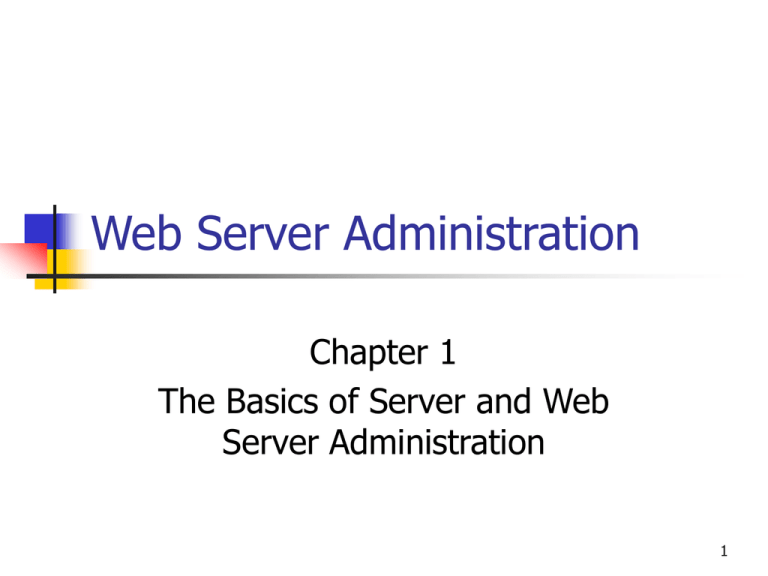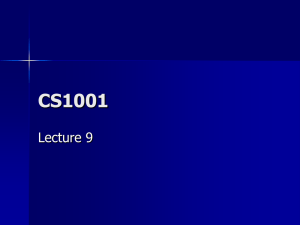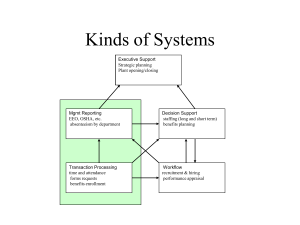Web Server Administration Chapter 1 The Basics of Server and Web Server Administration
advertisement

Web Server Administration Chapter 1 The Basics of Server and Web Server Administration 1 Overview Review the Internet and the World Wide Web Learn about server administration Learn about Web server administration Explore the common tasks and services performed by administrators Examine networking building blocks Compare Web server platforms 2 Review the Internet and the World Wide Web The Internet is a worldwide network of networks Where the Internet uses the HTTP protocol, it is called the Web Shares WAN used by the international telecommunications network Uses TCP/IP Web servers use HTTP to communicate The Internet is not centrally controlled 3 Review the Internet and the World Wide Web Internet had its origins in the 1960s In 1995 a high-speed backbone was created Included 4 network access points (NAPs) More have been created since then Now much Internet traffic is handled without going through NAPs Peering agreements allow this 4 Understanding Server Administration Server administrators Focus on the LAN Provide access to software and services Make sure environment is reliable and consistent Minimize harm that users can do to network 5 Working with Users A LAN can server hundreds or even thousands of users Users need to be productive Users like consistency Roaming profiles allow users to have the same personalized desktop environment on multiple computers 6 Establishing Access Control Users need just enough access to do their jobs, but not more Typically, users are organized into groups, and groups are given access to network resources Users can be given different access to the same resources A document can be read by everyone but modified by only specific people 7 Understanding the Server Environment All but the smallest network includes more than one server With Windows computers, servers and users’ computers can be organized into domains in order to centralize control In Windows 2000 and Windows Server 2003, domains can be grouped into forests 8 Understanding Web server Administration Web server administrators focus on the Internet Need to work with ISPs and Web page developers Typically, a Web server provides information to anyone who requests it over the Internet Web servers can contain other applications such as FTP and e-mail 9 Understanding Web server Administration Depending on the size of the organization, some tasks may be delegated Web page development Database design Programming E-mail administration Security 10 Selecting Programs and Databases Web server administrators need to install programming languages Web developers use a variety of languages Active Server Pages (ASP) ASP.Net Original language from Microsoft A newer environment that includes many languages Java Server Pages (JSP) 11 Selecting Programs and Databases Non-Microsoft languages are popular, even on Microsoft Web servers Perl – one of the first and still popular PHP – easy to use Java Server Pages (JSP) Macromedia ColdFusion 12 Selecting Programs and Databases A database management system (DBMS) is used to store data used with Web pages Microsoft Access is appropriate for small sites Microsoft SQL Server, Oracle 9i, and MySQL are sophisticated DBMSs for larger sites Standard Query Language (SQL) is the language used to communicate with the DBMS 13 Managing E-mail Servers Open by design to accept e-mail from anyone Spam can be a problem to manage Specific utilities can be used to help minimize spam Viruses are commonly sent by e-mail Use virus detection software and keep it updated 14 Other Applications Firewall FTP Helps protect your Web server environment from attack A service that allows users to download files from and upload files to a server DNS Translates host names such as www.technowidgets.com to an IP address 15 Administrators' Common Tasks and Services Installing and configuring systems Maintaining security Monitoring the system Maintenance and backup 16 Network Building BlocksThe OSI Model Layer Name Description 7 Application Responsible for low-level application access to the network. 6 Presentation Can convert data into a format that is understandable to the Application layer. 5 Session Can open, maintain, and shut down communication. 4 Transport Responsible for transporting the data from one computer to another. (TCP and UDP) 3 Network Primarily responsible for addressing between two computers. (IP and ICMP) 2 Data Link Responsible for the interface between the packets coming down through the upper layers and the physical layer. 1 Physical Responsible for transferring the data to the network medium. 17 TCP/IP Model Layer Name Common Components OSI Reference Application HTTP, SMTP, POP3 FTP, DNS Application Presentation Session Transport TCP, UDP Transport Network IP, ICMP Network Physical Ethernet, FDDI Data Link Physical 18 TCP/IP Protocols Hypertext Transfer Protocol (HTTP) Simple Mail Transfer Protocol (SMTP) Web servers implement this protocol Used by e-mail servers (and sometimes Web servers) to send e-mail Post Office Protocol Version 3 (POP3) Used to retrieve e-mail 19 TCP/IP Protocols File Transfer Protocol (FTP) Domain Name Service (DNS) Transfers files to and from server Translates host names to IP addresses and IP addresses to host names Transmission Control Protocol (TCP) Creates a reliable connection between two computers 20 TCP/IP Protocols User Datagram Protocol (UDP) Internet Protocol (IP) Does not establish a connection, just sends messages Provides addressing scheme Internet Control Message Protocol (ICMP) Provides error messages 21 Connecting Your LAN to the Internet Your ISP connects to the Internet A WAN connection is used between your building and the ISP A T-Carrier connection is often used A digital connection for voice and data 22 Common T-Carrier Connections 23 Connecting to the Internet 24 Other ways to Connect to the Internet Integrated services digital network (ISDN) Digital Subscriber Line (DSL) Dial-up access Basic Rate Interface (BRI) up to 128 Kbps Primary Rate Interface (PRI) up to 1.544 Mbps Often differing speeds for uploads and downloads Depending on type, up to 6.1 Mbps for downloads and 1.544 Mbps for uploads Cable Modem Shared access cable provided by cable TV company 25 Web Hosting Solutions Standard hosting Dedicated server Your site resides on the same computer with many other sites Cheapest solution You have a server that only you use Co-location Your own server is physically located at the company that does your Web hosting 26 Web Server PlatformsMicrosoft Windows NT (IIS 4) Windows 2000 (IIS 5) IIS (Internet Information Server) was added in the mid-1990s, and support for ASP was added later IIS part of the OS from the beginning .NET Framework add-on allows use of ASP.NET Windows Server 2003 (IIS 6) .NET Framework integrated into OS 27 Other Microsoft Server Products Application Center Biztalk Server Allows you to manage a cluster of servers as if it is one server Connects to your business partners using XML Commerce Server Builds e-commerce sites in a short amount of time 28 Other Microsoft Server Products Internet Security and Acceleration Server Operations Manager Combines a firewall product with a Web cache Helps decrease support costs for a server environment SharePoint Portal Server Set up a site that is highly personalized 29 UNIX/Linux UNIX was introduced in 1969 Linux is from the early 1990s Based on MINIX Three basic components Kernel – central portion of OS File system – provides input and output mechanisms Shell – provides user interface 30 Linux Source code is freely available Developers can make changes Available from a number of organizations Red Hat Mandrake SuSe 31 Summary Server administration focuses on LANs Web server administration focuses on the Internet Both types of administrators install, configure, and maintain servers Many pieces make up the network There are many Web server platforms from which to choose 32

